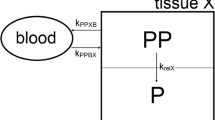Abstract
The systemic degradation and reticuloendothelial system (RES) uptake of cisplatin (CDDP)-encapsulated thermosensitive liposomes composed of dipalmitoylphosphatidylcholine (DPPC) and di-stearoylphosphatidylcholine (DSPC) (DPPC/DSPC = 9/1, 7/3, and 5/5, w/w) after intravenous administration to rats were examined by measuring the platinum (Pt) levels in the blood and RES (liver and spleen). The blood liposome level profile showed first-order rate elimination for each liposome administration. The elimination rate (K e1) was faster when the content of DSPC was lower (K e1: 1.3/hr for 9/1-liposomes, 0.7/hr for 7/3-liposomes, 0.5/hrfor5/5-liposomes). On the other hand, the RES liposome level profile showed distribution of liposomes followed by elimination therefrom. The RES level of the liposomes was lower when the content of DSPC was smaller (maximal level: 25% for 9/1-liposomes at 1 hr, 32% for 7/3-liposomes at 1 hr, 37% for 5/5-liposomes at 2 hr). The kinetic analysis demonstrated that the RES uptake rate (K res) was almost the same among the liposomes (0.4/hr), while the systemic degradation rate (K deg; K e1 − K res) became larger as the content of DSPC decreased (0.9/hr for 9/1-liposomes, 0.3/hr for 7/3-liposomes, and 0.1/hr for 5/5-liposomes) and that the RES liposome distribution amount was dependent not only on the K res but also on the K deg and the rate of RES liposome degradation. The K deg for each type of liposome corresponded with the systemic CDDP release rate.
Similar content being viewed by others
REFERENCES
M. B. Yatvin, J. N. Weinstein, W. H. Dennis, and R. Blumenthal. Design of liposomes for enhanced local release of drugs by hyperthermia. Science 202:1290–1293 (1978).
K. Iga, N. Hamaguchi, Y. Igari, Y. Ogawa, H. Toguchi, and T. Shimamoto. Heat-specific drug-release of large unilamellar vesicle as hyperthermia-mediated targeting delivery. Int. J. Pharm. 57:241–251 (1989).
K. Iga, N. Hamaguchi, Y. Igari, Y. Ogawa, H. Toguchi, and T. Shimamoto. Increased tumor cisplatin levels in heated tumor in mice after administration of thermosensitive large unilamellar vesicles encapsulating cisplatin. J. Pharm. Sci. 80:522–525 (1991).
J. Senior. Fate and behavior of liposomes in vivo: A review of controlling factors, CRC Crit. Rev. Ther. Drug Carriers 3:123–193 (1988).
A. Rahman, D. Carmichael, M. Harris, and J. K. Roh. Comparative pharmacokinetics of free doxorubicin and doxorubicin entrapped in cardiolipin liposomes. Cancer Res. 46:2295–2299 (1986).
J. Lautersztain, R. Perez-Soler, A. R. Khokhar, R. A. Newman, and G. Lopez-Berestein. Pharmacokinetics and tissue distribution of liposome-encapsulated cis-bis-N-decyliminodiacetato-1, 2,-diaminocyclohexane-platinum (II). Cancer Chemother. Pharmacol. 18:93–97 (1986).
P. A. Steerenberg, G. Storm, G. De'Groot, A. Kaessen, J. J. Bergers, M. A. M. Franken, Q. G. C. M. Van'Hoesel, K. L. Wubs, and W. H. De'Jong. Liposomes as drug carrier system for diamminedichloroplatinum(II): Antitumor activity in vivo, induction of drug resistance, nephrotoxity and Pt distribution. Cancer Chemother. Pharmacol. 21:299–307 (1988).
H. Harashima, Y. Kume, C. Yamane, and H. Kiwada. Non-Michaelis-Menten type hepatic uptake of liposomes in the rat. J. Pharm. Pharmacol. 44:707–712 (1992).
J. R. Gillette and K. S. Pang. Theoretic aspects of pharmacokinetic drug interactions. Clin. Pharmacol. Ther. 22:623–639 (1977).
Y. Sugiyama. Reconstruction of drug dispositions in vivo from in vitro studies based on physiological pharmacokinetic modeling: From low-molecular weight drugs to polypeptide compounds. Yakugaku-Zasshi 109:199–231 (1989) (Japanese).
K. Iga, Y. Ogawa, T. Yashiki, and T. Shimamoto. Estimation of drug absorption rates using a deconvolution method with nonequal sampling times. J. Pharmacokin. Biopharm. 14:213–225 (1986).
T. M. Allen. Stealth liposomes: Avoiding reticuloendothelial uptake. In G. Lopez-Berenstein and I. Fidler (eds.), Liposomes in the Therapy of Infectious Diseases and Cancer, Alan R. Liss, New York, 1989, pp. 405–415.
T. Irie, Y. Hashimoto, A. Irie, M. Ishibashi, H. Miyazaki, H. Machida, Y. Karasawa, and K. Nakamori. Absorption, excretion and distribution of cisplatin in dogs and rats. Iyakuhin Kenkyu 14:384–410 (1983) (Japanese).
Author information
Authors and Affiliations
Rights and permissions
About this article
Cite this article
Iga, K., Ogawa, Y. & Toguchi, H. Rates of Systemic Degradation and Reticuloendothelial System (RES) Uptake of Thermosensitive Liposome Encapsulating Cisplatin in Rats. Pharm Res 10, 1332–1337 (1993). https://doi.org/10.1023/A:1018925931294
Issue Date:
DOI: https://doi.org/10.1023/A:1018925931294




